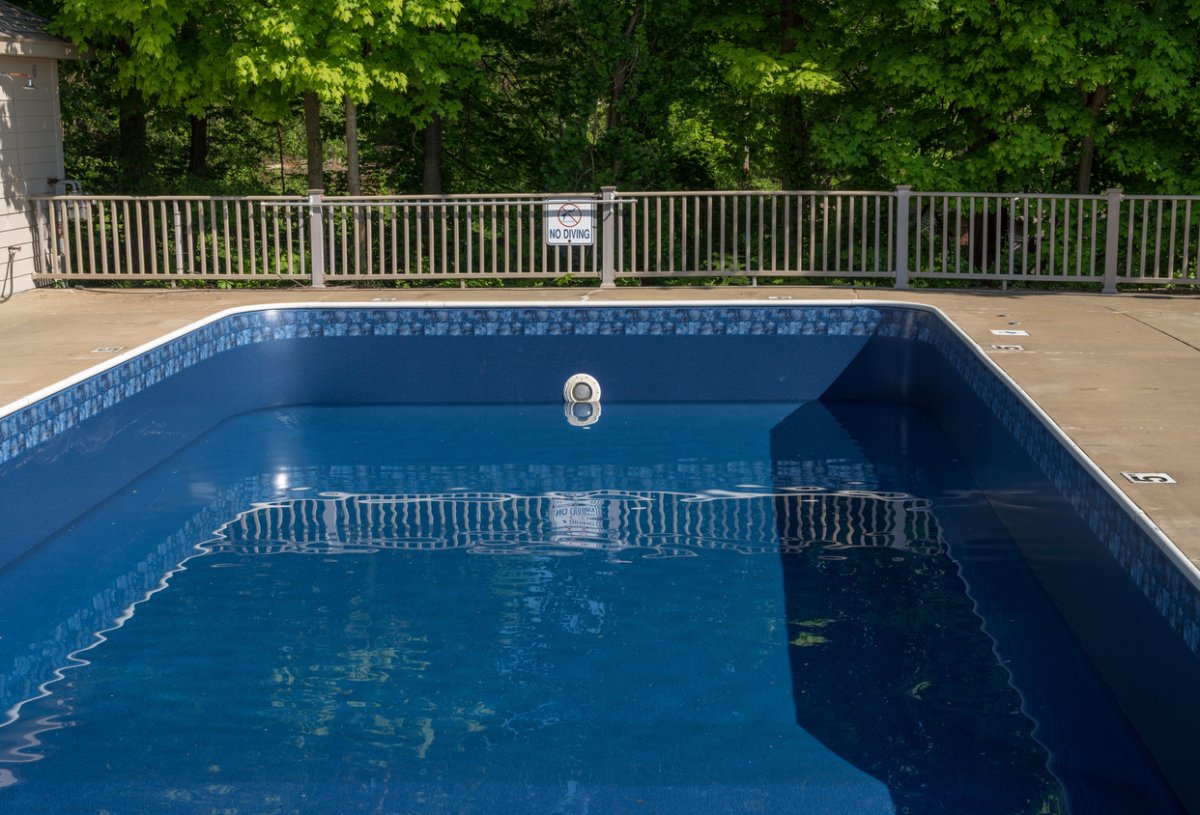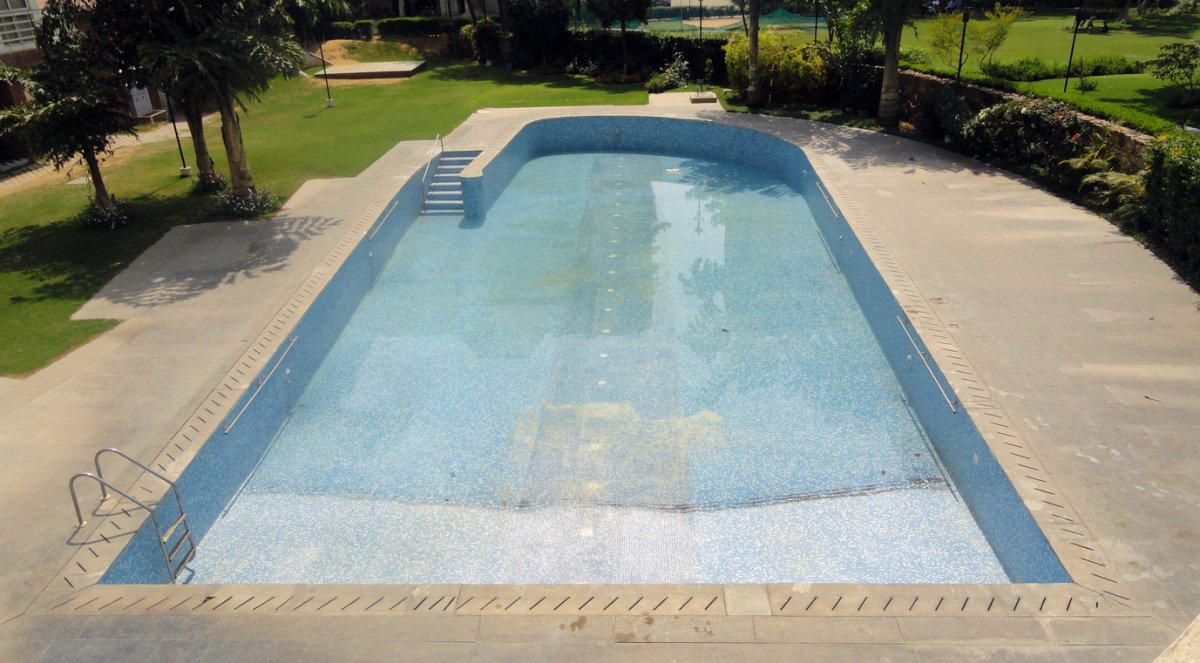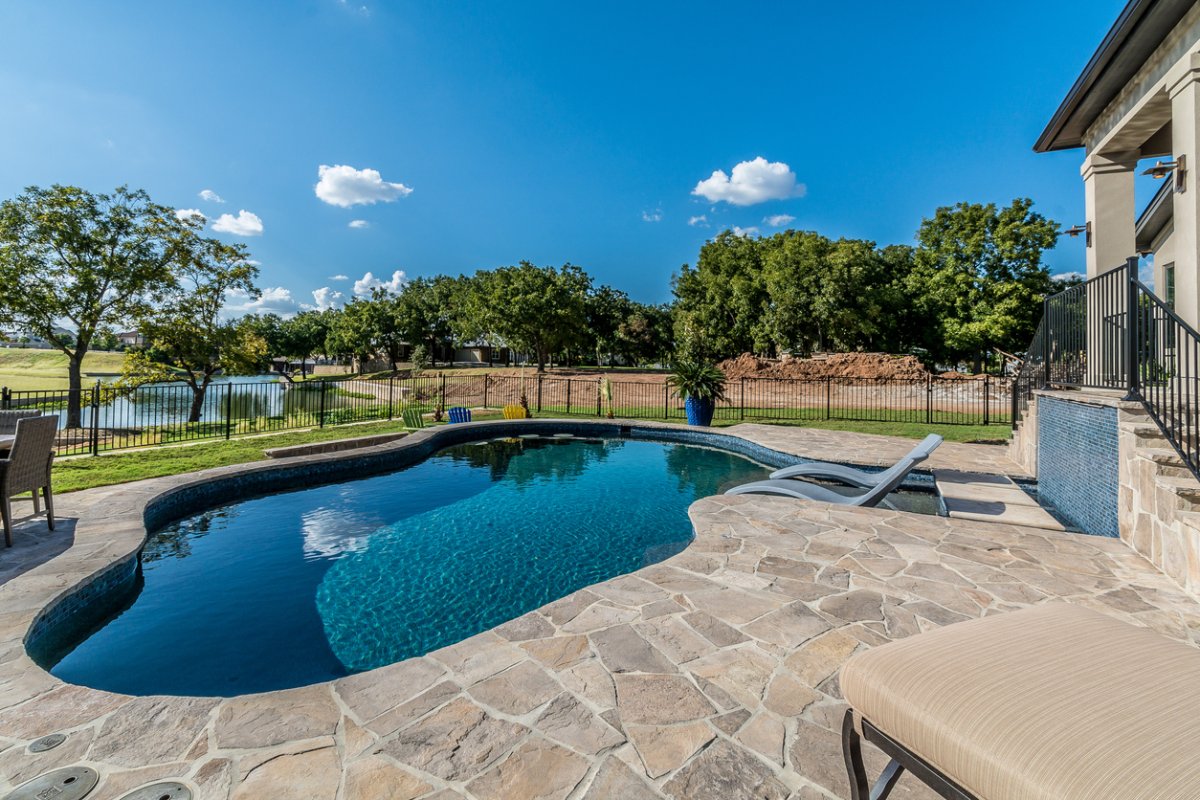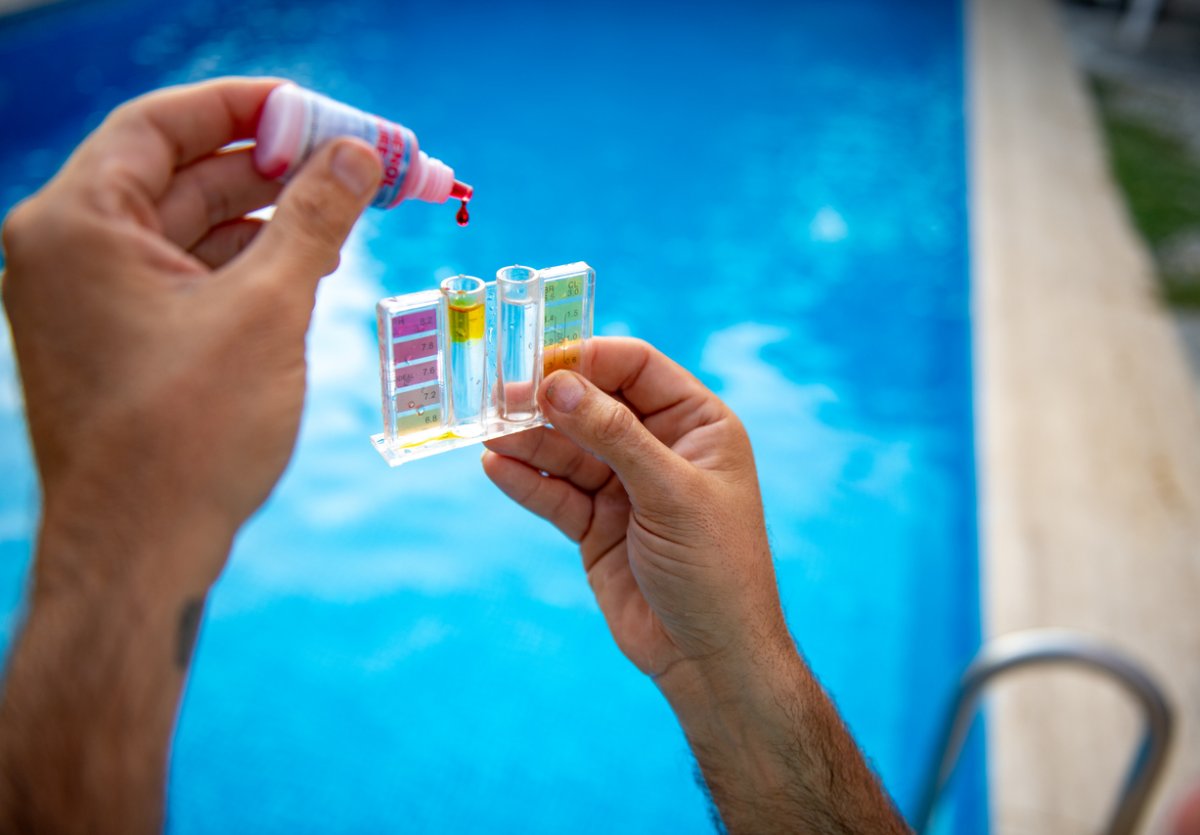

We may earn revenue from the products available on this page and participate in affiliate programs. Learn More ›
What You Need to Know
- It’s normal for pools to lose about ¼ inch of water each day from splashing or evaporation.
- Significant water loss may be due to either excessive evaporation or a leak.
- Pool owners can determine whether evaporation or a leak is causing their pool to lose water by using the bucket test and the dye test.
- Evaporation issues can be solved by installing a solar cover. Pool leaks typically need to be addressed by pool repair professionals.
Q: I’ve noticed my pool has lost a significant amount of water lately. Why is my pool losing water, and how can I fix it?
A: Nothing can ruin a relaxing day of lounging poolside or kicking back on a pool float like the realization that your pool is rapidly losing water. All pools lose a small amount of water each day to evaporation and splashing. However, an excessive drop in a pool’s water level is typically due to either a more significant evaporation issue or a leak. Both causes require attention, as low water levels can lead to more serious problems, such as poor pool circulation.
If there’s not enough water in a pool, the pump and filtration systems’ efficiency becomes compromised. As a result, the pool’s water can become cloudy, algae growth can increase, and the pool equipment may even become damaged. Consistent water loss also means frequent pool refilling, which increases water usage and utility bills and requires more chemicals to maintain water quality and hygiene.
If water loss is happening because of a leak, the rapid and excessive water loss can threaten the pool’s structure and surrounding materials. That’s why it’s so important for homeowners to be able to spot the difference between evaporation and water leaks in their pools.

How much pool water loss is normal?
According to Alicia Toedter, senior manager of content strategy at the national pool and spa care brand Leslie’s, “The average pool loses about ¼ inch of water per day unless a solar pool cover is used to cut down on evaporative water losses.” Evaporation is the primary cause of this water loss, and climate and environmental factors can exacerbate it.
“Pools in especially hot, dry, or windy climates can lose even more, as these factors increase the evaporation rate,” says Toedter. “Other things like splash-out and backwashing the filter can also remove water from the pool.”
These causes of water loss are normal, so it’s important to monitor water levels regularly to get to know typical reduction changes versus potential leaks. As a rule, it’s generally only necessary to add 1 to 2 inches of water to the pool each week. “If you’re noticing the water level dropping more than a couple of inches per week for no apparent reason, odds are you’re dealing with a pool leak,” Toedter adds.
How to Identify Pool Water Evaporation vs. Leaks
An excessive drop in pool water levels (beyond expected splash and evaporation loss) often points to a leaky pool. To maintain pool health, homeowners need to know the difference between environmental conditions causing evaporation and structural damage or a plumbing issue causing leaks.
Pool water evaporates more quickly in the spring and summer—if the problem worsens with warmer weather, evaporation is the likely cause.
Pool evaporation rates increase in the warmer months of spring and summer when temperatures are consistently warm. Both higher temperatures and intense sunlight contribute to faster evaporation of water from a pool’s surface.
If the water level in a pool drops more noticeably as the weather warms, it is likely that evaporation is the primary cause of water loss during these seasons. Additional environmental factors like lower humidity and increased wind can further accelerate this evaporation process. Rafi Friedman, president of Florida-based pool building company Coastal Luxury Outdoors, advises that pool owners pay regular attention to their pool and the weather forecast.
“Humidity levels play a big role in how quickly water will evaporate,” he says. “If things have been dry, more evaporation should be expected. If you notice a larger-than-usual dip in water level even when it’s humid, or especially if you’ve kept your pool covered, you may have a leak on your hands.”
| Season | Monthly Water Loss in Gallons | Monthly Water Loss in Inches |
| Winter | 712 | 2.8 |
| Spring | 1,950 | 7.8 |
| Summer | 2,450 | 10.1 |
| Fall | 1,400 | 5.7 |
If homeowners find themselves adding water to their pool at higher volumes or more frequently than average water loss rates require, this could be a sign of a leak. The best way to combat this issue typically involves installing a solar cover for the pool. Additionally, covering the pool area with a pool enclosure can also help. A pool screen enclosure costs between $5,708 and $16,608 on average.

Excessive moisture or an accumulation of standing water surrounding the pool is a clear sign that the pool is leaking.
When a pool leaks, the water typically seeps into the ground surrounding the pool. Depending on the pool’s location, this could result in sinking decks or patios, muddy or soggy spots in the grass, or even cracks appearing on the surface of the concrete surrounding the pool. “If you notice unusually soggy spots in your lawn, or water trickling out of your lawn into a nearby gutter or storm drain, it may be coming from your pool,” Friedman says.
Over time, water seepage from a leaking pool can cause soil erosion or damage the pool’s structural integrity and the surrounding area. It’s important to address any signs of pool leaks right away to avoid costly repairs.
You may notice an increase in the amount of chemicals the pool requires as a water leak advances.
Treating a pool with chemicals is an essential part of both in-ground and above-ground pool maintenance. Homeowners may notice they need to increase the amount of pool stabilizers and other chemicals required to maintain the water quality if they have a swimming pool leak. The fresh water added from the hose to compensate for the leaked water will dilute the existing chemical balance in the pool, making it less effective. More chlorine, algaecides, and pH balancers are needed to keep the pool water clear and safe for swimming.
“A sudden increase in chemical usage or difficulty maintaining proper water chemistry can…be indicators of a leak,” said Toedter. “This is especially true if you’re using an auto-fill valve that adds fresh water automatically.” Early leak detection in swimming pools can lessen pool maintenance costs in the form of water and chemicals.
For those with automatically filling pools, soaring water bills are another sign of a pool leak.
Automatic filling pools are designed to maintain water levels seamlessly; however, a leak will cause the system to go into overdrive. More water will be needed than usual, which will result in significantly higher water costs over time. Since the pool is being refilled constantly, it may not be obvious that the pool is losing water until the utility bill comes.
If a homeowner notices the system is running more frequently than normal—especially without increased usage or evaporation conditions—it’s likely a sign that water is escaping through an unseen leak.
Visible cracks in the lining or surface of the pool can signal a leak and may lead to larger structural issues.
It’s worth doing a visual inspection of the pool for any cracks. If there is water seeping through these fractures, it can undermine the integrity of the surrounding area and the base of the pool.
“Once you’ve found the crack, drain your pool below that point, then address the problem,” says Friedman. “Small cracks can be dealt with using at-home patch kits or sealer, while bigger ones should be left to professionals.” Taking a proactive approach to pool leak detection will prevent escalated repair costs and a possible pool closure to fix a significant leak.
A “bucket test” can be done to determine whether the water loss is due to a leak or excessive evaporation.
Jimmie Meece, brand president of national pool service franchise America’s Swimming Pool Company, recommends performing the “bucket test” to rule out normal evaporation and potentially detect a leak in a pool.
To do this, fill a bucket with pool water and place it on the first or second step inside the pool so the water level inside the bucket matches the water level inside the pool. Mark both water levels inside and outside the bucket. Leave the bucket in this spot for 24 hours without adding any additional water to the pool during this time. Then, compare the water levels after the test window. “If the pool water, which is the outside mark on the bucket, goes down more than the inside water level, there is probably a leak,” says Meece. “Document the water level drop in inches.”
Meece also notes that if it rains during the 24-hour period, homeowners will need to repeat the bucket test to confirm the leak. As a follow-up test for a suspected leak, Meece also recommends the “24 hours on” test to differentiate between a leak in the plumbing system and one in the shell of the pool. To do this, fill the pool so the water level is neither above nor below the skimmer, then mark the level. Turn off any auto-fill valves and run the pool pump for a full 24 hours before checking the water level again. If the water level has dropped below the mark, it could indicate a plumbing leak.
Meece adds that it’s important to make sure that no water is leaking from the “backwash line,” (the pipe carrying waste water away from the pool) when the pump is running. “If you’re losing water from the backwash line, you’ll need to repair or replace the multiport valve on your filter,” says Meece.

If you do have a leak, a “dye test” can help you pinpoint its location.
Once it’s clear that the problem is actually a leak, it’s time to learn how to find a leak in a pool.
“Certain clues may help you pinpoint exactly where the leak is coming from, if not readily apparent,” Toedter says. “For example, does the water level drop faster when the pump is on? If you turn the pump off and let the water level drop, does it stop at a certain point in the pool?” The most common leak areas include the skimmer, pool lights, plumbing returns, cracks or tears in pool surfaces, and plumbing joints and unions that connect your equipment to the pool.
In the absence of these clues, a dye test can help determine the leak location. This is when a small amount of dye—food coloring or a specially formulated dye—is introduced to the pool while the water is still and the pumps are not running.
Apply the dye near cracks, fittings, and around the edges of the pool liner—anywhere leaks are most likely to occur. The dye will flow toward the leak to visually show the homeowner where the pool is losing water and make the process of finding a pool leak much easier. Once identified, some cracks can be temporarily repaired with a pool patch, but it’s a good idea to have a professional inspect the pool and perform more permanent repairs.
Who to Call for Pool Leak Repair
For advanced leak detection, Toedter says that a pool service professional may be needed to pinpoint the exact location. “This is especially true for underground plumbing leaks that may have resulted from freeze damage or shifting soil,” she adds.
A pool repair company has the expertise and tools for detecting pool leaks that might not be readily accessible to homeowners. Some of the best pool cleaning services and best pool installation companies also offer repairs, so homeowners who already use these services may want to inquire about this if they suspect a leak.
First, the pool technician will perform a pool inspection to assess the problem. A pool inspection costs about $125 to $250. Following a thorough inspection, a pool service specialist may recommend solutions ranging from pool resurfacing or liner replacement (homeowners can expect pool resurfacing costs of around $6,500, and pool liner replacement costs $2,393 on average). The cost of pool leak repairs seems minimal when the root cause of water loss is identified and effectively addressed. Additionally, pool professionals often provide valuable maintenance tips and strategies to prevent future issues and keep the pool in optimal condition for safe and enjoyable use.
Angi, Poolwerx.com
